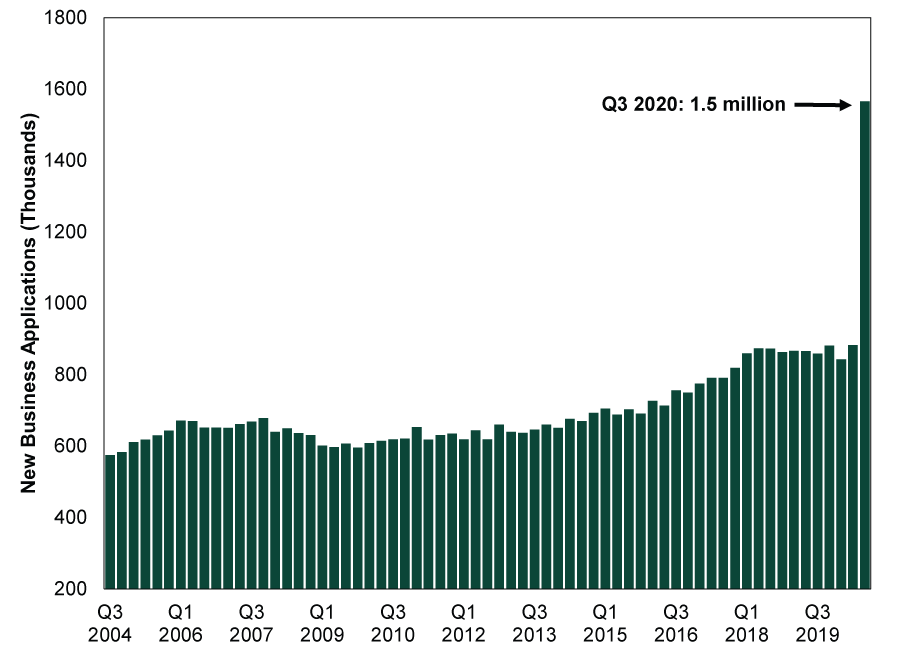Personal Wealth Management / Market Analysis
A Reason for Optimism in Today’s Trying Times
Per recent Census data, the American entrepreneurial spirit persists—a reason to be optimistic about the future.
2020’s laundry list of challenges and tragedies runs long. The COVID-19 pandemic. Natural disasters, including catastrophic wildfires and hurricanes. Social unrest. Beyond this year, many say the longer-term outlook is in shambles, too, from Social Security’s uncertain future to skyrocketing federal debt. Some go so far as to argue it reveals a chasm in our economic system. We don’t dismiss either the short-term or long-term challenges, but it is premature to write off humanity’s ability to address them, courtesy of the free market’s boundless opportunities. Recent Census data highlight the resiliency of the American entrepreneurial spirit—a reason to be optimistic about the future, in our view.
Per the Census Bureau’s latest “Business Formation Statistics” report, Employer Identification Number applications—which new businesses submit with the IRS—hit 1.5 million nationwide in Q3, a 77.4% quarter-over-quarter rise and the most since records began in mid-2004.[i] Applications boomed throughout the country—particularly in the South—and the Census Bureau found 34% of all submissions were for “high-propensity” businesses (i.e., those likely to hire people).[ii]
Exhibit 1: A Surge in New Business Applications

Source: US Census Bureau, as of 10/28/2020. Seasonally adjusted business applications, quarterly, Q3 2004 – Q3 2020.
We aren’t saying these data indicate something meaningful about the economy’s near-term prospects, as new business applications don’t immediately reverse the damage from permanently closed businesses or give today’s jobless an opportunity. These data also go back only about a decade and a half, making it difficult to put these numbers in a broader historical context. Moreover, not all applications will turn into full-fledged, successful businesses. Some will take off, but many will fail. According to BLS data, approximately 21% of new businesses fail in their first year.[iii] The attrition rate slows some thereafter, but regardless, just 16.6% of businesses opening in the 12 months ending March 1994 survived through March 2019.[iv]
Running a business is a tall endeavor, as entrepreneurs must navigate the business cycle, sector and industry changes as well as myriad unforeseen variables to remain profitable. Yet this turbulence is a feature, not a bug, of capitalism. The Austrian economist Joseph Schumpter called it creative destruction—the process “… that incessantly revolutionizes the economic structure from within, incessantly destroying the old one, incessantly creating a new one.”[v] Surviving businesses are the ones that innovate and adapt best to provide goods and services to their customers in a dynamic world. They also very often build off failures that came before them.
In our view, the nationwide surge in business applications signals the American entrepreneurial spirit is alive and well. Whether out of necessity or inspiration, Americans remain willing to risk starting a new business—evidence of people’s resiliency in the face of adversity. We think this mentality is the fuel that drives economic recoveries—and is also reason to be optimistic about humanity’s ability to tackle longer-term issues. Fears of insurmountable problems litter history, from the Malthusian trap to “peak oil.” Yet creative, entrepreneurial individuals, driven by free markets, keep finding solutions (see: technological advances in agriculture and oil extraction)—which contribute to and spur economic growth. Though we don’t know the answers to tomorrow’s challenges, the spirit that inspires those innovations persists.
None of this is going to turbocharge stock markets or economic growth in the near term. In other words, we aren’t arguing soaring business formation is bullish today. However, it argues against the notion today’s obstacles are unbeatable. Creative people, driven by the profit motive, remain willing to take on those challenges—a reason to be optimistic in today’s trying times.
[i] Source: US Census Bureau, as of 10/28/2020. Business Formation Statistics, Third Quarter 2020.
[ii] Ibid.
[iii] Source: Bureau of Labor Statistics, as of 10/28/2020. Statement based on survival of private sector establishments after first year of opening, March 1994 – March 2018.
[iv] Source: Bureau of Labor Statistics, as of 10/28/2020. Survival of private sector establishments by opening year, March 1994 – March 2019.
[v] “Creative Destruction,” Richard Alm and W. Michael Cox, The Library of Economics and Liberty, https://www.econlib.org/library/Enc/CreativeDestruction.html. Date accessed: 10/30/2020.
If you would like to contact the editors responsible for this article, please message MarketMinder directly.
*The content contained in this article represents only the opinions and viewpoints of the Fisher Investments editorial staff.
Get a weekly roundup of our market insights
Sign up for our weekly e-mail newsletter.

You Imagine Your Future. We Help You Get There.
Are you ready to start your journey to a better financial future?

Where Might the Market Go Next?
Confidently tackle the market’s ups and downs with independent research and analysis that tells you where we think stocks are headed—and why.





